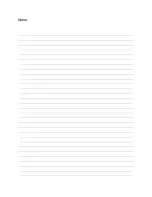
10 Materials
Temperatures and the
heatbed
treatment before
according to a specific
material
.
10.1 ABS
Material suitable for common, robust objects.
● Nozzle temperature:
255
°C
● Bed temperature:
100 °C. You can set the bed temperature between 80 to 110 °C
depending the
size
of an object (larger object means higher temperature)
● Heatbed:
Make sure the surface is clean as described in
6.3.1 PEI print surface
preparation
chapter
10.2 PLA
Material suitable for
detailed
models
. PLA is made of renewable sources, mostly from the
cornflour and cellulose.
● Nozzle temperature:
210 °C
● Bed temperature:
50 60 °C
● Heatbed:
Make sure the surface is clean, as described in
6.3.1 PEI print surface
preparation
chapter
10.3 PET
Material suitable for large objects thanks to its minimal thermal expansion. Universal
material
suited also for printable
mechanical
components.
● Nozzle temperature:
240 °C
● Bed temperature:
80 100 °C
● Heatbed:
Make sure the surface is clean, as described in
6.3.1 PEI print surface
preparation
chapter
10.4 HIPS
Universal, stable
material
with good heat resistance suited for printable
mechanical
components.
● Nozzle temperature:
220 °C
● Bed temperature:
100 °C. You can set the bed temperature between 80 to 110 °C
depending the
size
of an object (larger object means higher temperature)
● Heatbed:
Make sure the surface is clean, as described in
6.3.1 PEI print surface
preparation
chapter
10.5 PP
Polypropylene is a flexible and resistant
material
suitable for
printing
of the precise objects
requiring the flexibility, firmness and persistence.
● Nozzle temperature:
254 °C
● Bed temperature:
95 100 °C.
● Heatbed:
The best results are obtained with common scotch tape just attach the
tape directly to the print surface and clean it after the print is finished.
10.6 Nylon (Taulman Bridge)
Nylon is very tough material suitable for mechanical parts.
● Nozzle temperature:
240 °C
● Bed temperature:
80
90 °C.
● Heatbed:
Use one coat of gluestick. Clean as described after the print.
34













































